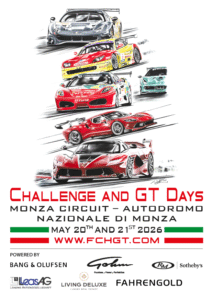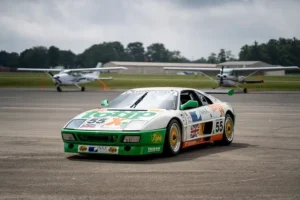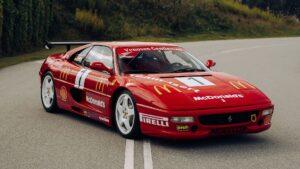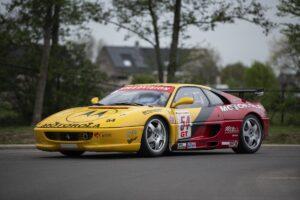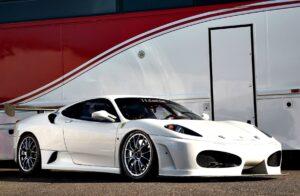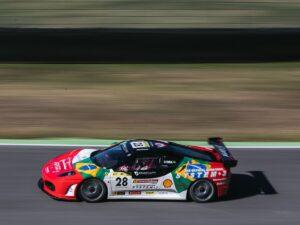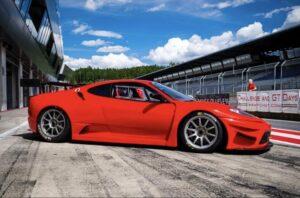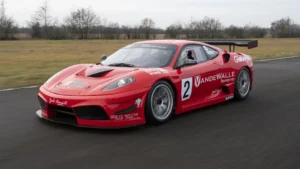Last update 19.11.2025
You want to BUY or SELL a Ferrari Challenge or GT Car?
Send us details and pictures, we will post it, for free…
Forza Ferrari
9. Edition Challenge and GT Days 20 and 21 of May 2026
Details about the event HERE
Pictures from 2025 HERE
_____________________________________________________________________
+++We as site operators assume no liability or guarantee for the displayed vehicles, we only try to give you an overview what cars are on the market and for sale+++
__________________________________________________________________________
For sale – 1993 Ferrari 348 LM
For sale is a 1993 Ferrari 348 LM – Details and more pictures HERE
Wonderful LeMans race car, documented history, superb condition!
_____________________________________________________________________
For sale – 1996 Ferrari F355 Challenge
For sale by Broad Arrow Zoute Auction – 10 October 2025
Details and more pictures HERE
Price EUR 295.000,–
-
Kilometerstand 43 478 km / 27 016 mi
More pictures and informations HERE
Chassis No. ZFFPR41B000104660
When Ferrari introduced the F355 in 1994, it signaled a decisive return to form. Pininfarina refined the 348’s profile into a classically beautiful shape, highlighted by elegant flying buttresses, while beneath the surface, the car was a technological showcase. Its 3.5-liter V8, equipped with five valves per cylinder, titanium connecting rods, and Bosch engine management, produced 380 PS, placing it among the most advanced engines of its day. Combined with an aerodynamically sculpted underbody and electronically adjustable dampers, the F355 was more than five seconds faster around Fiorano than its predecessor.
Building on this foundation, Ferrari unveiled the F355 Challenge in 1995 for its one-make Ferrari Challenge series. Developed from the Berlinetta, all Challenge cars began life as road cars and were converted with a factory kit supplied through dealers costing nearly €25.000. The package included a full roll cage, racing seats and harnesses, a fire extinguisher, a competition clutch, a lightweight exhaust, and upgraded Brembo brakes sourced from the F40. Magnesium Speedline wheels wearing Pirelli tires, solid suspension bushings, cooling ducts, and tow hooks completed the specification, while a perforated rear grille improved cooling.
While the engine output and dimensions are the same as the roadgoing F355, the Challenge’s six-speed manual transmission was sealed against modification to ensure parity on track. Just 300 examples were created between 1995 and 1998, making the F355 Challenge one of the rarest and most desirable modern-era competition Ferraris.
First registered on 19 March 1996, the car was delivered by legendary Ferrari Scuderia Auto Neuser in Nürnberg to Harald Brutschin. Already a seasoned driver, Brutschin won the Ferrari Challenge Middle European Championship in 1994 in a 348 Challenge, and again in 1995 behind the wheel of an F355 Challenge. For the 1996 season, this new F355 Challenge car was finished in the iconic McDonald’s livery and raced under the Neuser team name. Following this season, the car was used on a more limited basis.
In recent years, the car underwent a comprehensive, photo documented restoration. This extensive work is said to include an engine-out service with the timing belts replaced. A compression test was performed at this time, with the results available for review in the accompanying history file. After one and a half years of work, the car was brought to its current stunning condition.
Today, this iconic McDonald’s-liveried F355 Challenge remains in outstanding condition displaying just 43,478 kilometers at cataloging. It is furnished with the original Fahrzeugbrief still in Brutschin’s name, leather folio housing its owner’s manual and service book, as well as three binders documenting its race history, service invoices, and more. More than just a beautifully restored Ferrari race car, this F355 has the added distinction of being retained by a single private owner from new, with a fantastic racing pedigree. The F355 also has the added benefit of being one of the only Challenge cars to be legal for road use in one of the most iconic liveries. Whether for concours use or continued track use, this F355 surely is one of the finest currently available and would be the ideal addition to any noteworthy Ferrari stable.
_____________________________________________________________________
For sale – 1998 Ferrari F355 Challenge
For sale is a 1998 Ferrari F355 Challenge
More details and pictures HERE
- 1 of 108 Original F355 Challenge
Driven by Matt Drendel
in the North American Ferrari Challenge 1998 & 1999
P2 Overall in the 1999 Ferrari Challenge
Only 3 owners from new
Fantastic “Motorola” livery
Very collectable! - Price on Request
_____________________________________________________________________
For sale – 1994 Ferrari F355 Challenge
For sal in France is a Ferrari F355 Challenge. More details and pictures HERE at Classic Driver
Price 195.500 EUR
Details:
Immatriculée en France, championne du Challenge Ferrari Europe (1995, 1996) avec Lucien Guitteny, ayant couru en FFSA GT (1997-1999) et en courses de côtes (2010-2011). Dotée d’un arceau, baquets Sparco, aileron carbone. Performante et titrée. Vendue à professionnel de l’automobile uniquement.
For sale is a 2000 Ferrari 360 Challenge
Asking price is 69.500,– Euro
More photos and details HERE at Classic Driver
- Campaigned in the Ferrari Challenge Trofeo Pirelli from 2000 to 2004
- Orginal Lg Book and papers existing
- Driven by prominent GT drivers including Massimo Di Risio, Vitaliano Maccario, and double-IMSA GTD-class champion Alessandro Balzan
- Competed in the International GT Open series in 2006 and 2007, gaining class wins at Vallelunga and Monza, further to 2nd-in-class at Brands Hatch
- Benefits from a June 2023 service by official Ferrari service centre, Passione Sportiva and another overall service in 2024 at Ferrari specialist Rebello Racing
- Presented with Ferrari Challenge designe and specifications
- around 13.000,– Euro invested at a Ferrari specialist in 2024
Originally sold to the Di Risio Competizione team for use in the popular Ferrari Challenge Trofeo Pirelli, chassis 119529 was driven by several notable drivers between 2000 and 2004. These included team owner Massimo Di Risio, Vitaliano Maccario, and future Sebring 12 Hour class-winner, Alessandro Balzan. The car contested four seasons in the series—visiting historic circuits such as Monza, Mugello, Imola, and Vallelunga—prior to its sale to Scuderia Giudici, the eponymous team of accomplished endurance and sometime DTM competitor, Gianni Giudici.
In Giudici’s custody, the car was upgraded aerodynamically to comply with the regulations of the International GT Open series, in which it competed in 2006 and 2007 with Giuseppe Arlotti and Fabrizio Gini driving. Highlights of the team’s campaigns included class wins at Vallelunga and Monza, 2nd in class at Brands Hatch, and 3rd at Magny-Cours.
This 360 Challenge benefits from a service by official Ferrari agents Passione Sportiva of Austria as recently as June 2023 and another overall service in 2024 at Ferrari specialist Rebello Racing. This included the replacement of its timing belt, belt tensioners, and all fluids. This prodigiously fast track day weapon awaits its next owner as a worthy contender for entry to many of the relevant historic races for which it is eligible.
_____________________________________________________________________
For sale – 2002 Ferrari 360 Challenge
For sale is a 2022 Ferrari 360 Challenge by Classic Car Auctions
Estimate is 92.000 – 105.000 Euro
More details and pictures HERE
-
Chassis number
-
ZFFYR51B000119353
The 2002 Ferrari 360 Modena Challenge is a pure race car, developed for the Ferrari Challenge racing class and built to push performance to the limit. Whereas the standard 360 Modena was already an impressive sports car, the Challenge version was modified specifically for the track, with weight-saving measures, a stiffer suspension and sharper tuning. This model embodies Ferrari’s philosophy: speed, precision and an unfiltered driving experience.
Under the hood lies the same atmospheric 3.6-liter V8 as in the street version, but in the Challenge version it was sharpened even further. With 400 hp, eager throttle response and a roaring exhaust sound, the 360 Challenge leaves no doubt about its origins. The sequential F1 transmission ensures lightning-fast shifts, while the lighter weight and race-spec tuning make it even more agile than its street car counterpart. With a roll bar, four-point harnesses and plastic windows, this Ferrari is built for one purpose: to dominate the track.
This particular example has not only the right technical upgrades, but also an impressive history. Decked out in black with Sparco racing seats, BBS rims with half-slicks, a carbon rear wing and a Momo steering wheel, it exudes pure motorsport. Moreover, this 360 Challenge has made its mark in motorsport, with an award-winning career within the English GT Cup. In 2010, driver Marco Pullen managed to win the overall championship with this Ferrari – a testament to its competitive potential and reliability at the highest level.
The Ferrari 360 Challenge marked an important step in the evolution of Ferrari’s customer-oriented racing programs. It succeeded the F355 Challenge and brought even more Formula 1 technology to private teams and gentlemen drivers. The all-aluminum chassis, improved aerodynamics and refined suspension made the car not only faster, but also more manageable at the limit. This model was one of the first Ferraris to truly benefit from the brand’s experience in Formula 1 with its sequential shifting system.
While many racing cars fall into oblivion after their active careers, the 360 Challenge remains a beloved model among collectors and track enthusiasts. Thanks to its robust engineering and timeless Pininfarina design, it is a Ferrari that still impresses, both in the pits and on the track. For those looking for a pure and unadulterated racing experience, a 360 Challenge is one of the most direct and exciting ways to experience Ferrari DNA.
_____________________________________________________________________
For sale – 2000 Ferrari 360 Challenge
For sale is a 2000 Ferrari 360 Challenge
Asking price is EUR 171.000,–
All details and more photos HERE at Classic Driver
Limited to 270 units worldwide
8,000 km (Odometer is not available, so estimated/last overhaul was around 7,100 km, and only shakedown was done since then, so it’s likely around 7,200 to 7,300 km, but listed a bit higher just to be safe).
Shakedown completed
Interior refreshed
Engine overhauled
Brake rotors replaced
Left and right fuel pipes replaced
Challenge stickers re-applied
Bonnet hood inner and front trunk interior refreshed
_____________________________________________________________________
For sale – 2006 Ferrari F430 Challenge
Paddle F1 shift gearbox, Steel Brakes and upgraded FF Corse Aero kit.
Comprehensively raced in the UK and since used for track days by current owners FF Corse, the UK’s leading Ferrari Race Specialists. The chassis itself has covered 30,000kms, as has the engine, serviced regularly during its life, and benefits recently from new discs, disc bells and pads, new starter motor, engine and gearbox service.
Internally, the car comes with 2 seats with 2 multi point harness and a fire extinguisher system. Externally, upgrades feature air jacks, an FF Corse built and designed carbon fibre rear wing, carbon fibre front splitter and a factory fitted rear diffuser and a fast fill premier fuel system.
The F430 will be supplied in track ready preparation, and further support can be supplied upon request.
Currently eligible for multiple championships including GT Cup, British Endurance Championship (Britcar), Ferrari Club Racing Series, Amoc Racing GT Challenge and can be used on silenced track days also. A fabulous car ideally suited to beginners or serious racers, a cost effective way to race the Prancing Horse.
_____________________________________________________________________
For sale – Ferrari F430 Challenge ex Bruno Senna
More details and pictures HERE
Rosso Corsa / Original Senna Design – ex Bruno Senna
two times Ferrari Challenge Winner Silverstone 2007
Asking price is EUR 200.000,–
_____________________________________________________________________
For sale – 2008 Ferrari F430 GT3 Scuderia
For sale is a rare 2008 Ferrari F430 GT3 Scuderia – Only 23 are built!
Chassis ZFFEX63X000159159
Asking price is 259.000,– Euro
HERE you find the racing history
More details and pictures HERE at ClassicDriver
Car comes with a fresh service, a second pair of wheels and some parts.
_____________________________________________________________________
For sale by RM Sotheby’s – 2008 Ferrari F430 GT3 Scuderia
For sale by https://rmsothebys.com is a 2008 Ferrari F430 GT3 Scuderia
All details and more pictures HERE at RM Sotheby’s
- One of just 54 F430 Challenge chassis upgraded to GT3 specification by Ferrari Racing Partner team Kessel Racing.
- Delivered new to Belgian GT team Scuderia Monza in 2008.
- Further upgraded to Scuderia GT3 specification by Kessel Racing in 2010; one of only 25 cars to have received such modification.
- Campaigned extensively in Belcar Endurance and Sprint events between 2008 and 2011.
- Subsequently owned by renowned Ferrari specialists Toni Auto of Maranello from 2017 to 2022.
- Accompanied by Ferrari Classiche certification, referencing its original chassis and engine.
- Eligible for Club Competizione GT events, and prestigious Historic Racing series including Endurance Racing Legends and GT3 Legends.
The 1990s witnessed the welcome return of Production-derived GT cars to top line competition, with old sparring partners such as Ferrari and Porsche renewing hostilities in the new-for-1994 BPR Global GT series and its successor, the FIA GT Championship. However, increasing speeds and budgets led to the launch in 2006 of the FIA GT3 European Championship; this providing a competitive arena–and, crucially, a robust regulatory framework–for cars homologated with a more cost-conscious specification than the incumbent GT1 and GT2 machinery.
Several manufacturers were moved to develop cars for the new series, including Ferrari, Aston Martin and Audi. The former’s partner team, Kessel Racing, promptly homologated a GT3 upgrade package for the existing F430 Challenge model; modifications centring around an enlarged 4.5-litre V8 engine–affording a power increase from 490 to some 550 horsepower–and heavily revised aerodynamics and bodywork. Results were impressive, with the F430 GT3 of Hector Lester and Allen Simonsen winning the series’ inaugural race at Silverstone in 2006, and the Kessel Racing-run car of Henri Moser and Gilles Vannelet securing the Championship in 2007.
Just 54 F430 Challenge cars were converted to F430 GT3 specification by Kessel Racing, with this chassis, 159322, being delivered to the Belgian Scuderia Monza team. The team’s primary focus for 2008 and beyond was to be Belcar–the Belgian GT Championship in all but name–although the car made its race debut at August’s Zolder 24 Hours race. Driven by brothers Frank, Hans and Kurt Thiers, and veteran long-distance specialist Guy Van Mol, the car qualified 11th, prior to finishing a creditable 12th overall and sixth in class in the race.
Following a retirement in September’s Belcar round at Spa-Francorchamps, 159322’s third and final outing of the year saw a return to Zolder for the Belcar round supporting the FIA GT Championship. The 27-car entry boasted four F430 GT3s, although the two-part race was dominated by the Mosler MT900Rs. However, the team’s season ended on a high note, with Frank and Hans Thiers finishing the second race in fifth position; the pair beaten only by three Moslers and the sister F430 GT3 of Vincent Vosse and Eddy Renard.
For 2009, Scuderia Monza redoubled their Belcar efforts, with Frank and Hans Thiers driving 159322 exclusively. Although their opposition had increased notably over the Winter–with cars such as the Audi R8 GT3 and Aston Martin DBRS9 making their Series debuts–the season started strongly for the pair, with third- and seventh-placed finishes in the opening round at Zolder in April. A disappointing double retirement at Spa-Francorchamps in May was redressed somewhat by two further visits to the circuit that year; the June round yielding a ninth and sixth, while July saw the Thiers record an eighth and a sixth-placed finish. The season concluded at Zolder in October, in which the brothers finished seventh and eighth in the first and second races respectively.
In 2010, 159322 was returned to Kessel Racing for a further upgrade to Scuderia GT3 specification; the modifications being principally aerodynamic in nature. Duly renumbered 159322-SC21 to reflect its newly updated status, the car was one of just 25 chassis to receive such modification, and one of only seven updated that year.
Over the Winter, the Belcar Series had abandoned its “double header” format in favour of a single, longer race; the first round of the 2010 season, held at Zolder in April, being three hours in length. Having qualified only 13th, Frank and Hans Thiers drove a measured race to finish seventh overall, while at Spa in July they finished a fine fifth behind the likes of GT regulars Anthony Kumpen, Steven Kane and Bert Longin. The only other notable result of the year for the brothers was in the 125-minute season finale at Zolder, in which they finished ninth.
A partial Belcar campaign for Scuderia Monza in 2011 saw “SC21” contest only four races; the year commencing in challenging fashion with retirement in both early season rounds at Zolder. However, the three-hour race at Spa-Francorchamps in June saw a welcome change in fortune–and a superb GT3B class win–although Zolder once again proved to be the team’s bogey track, with the year concluding with a further enforced retirement in October’s season-closing round.
It is believed that the car remained in the care of the Thiers brothers until its acquisition by legendary Ferrari specialists Toni Auto of Maranello in 2017. Located barely 200 metres from the fabled Ferrari factory gates on the Via Abetone Inferiore, the company’s association with their illustrious neighbours stretches back to the early 1950s, with founder Franco Toni’s employment in Ferrari’s Race Department. Appropriately, Sig. Toni was seconded to Belgian Ferrari importers Garage Francorchamps for two years in 1954, making the involvement of his grandsons–the present proprietors of the business–with “SC21”, more than 60 years later, all the more poignant.
Acquired from Toni Auto by the vendor in 2022, but expertly maintained by them ever since, the car has been used only sparingly in the present ownership–and exclusively in non-competitive Club Competizione GT events, including most recently at the 2024 Finali Mondiali at Imola. Significantly, its ECU records cumulative chassis mileage of a relatively modest 16,730 kilometres from new, while the engine has covered just 5,000 kilometres since its most recent rebuild–with a further unexpired “life” of some 20,000 kilometres remaining. Additionally, the car’s gearbox, clutch, driveshafts and suspension are all listed as having covered just 1,500 kilometres since either rebuild or replacement.
Immaculately prepared–and fresh from its involvement in Ferrari’s Finali Mondi celebrations at Imola, “SC21” remains a highly significant example of this most versatile of Ferrari Competition GT cars; additionally representing an attractive and cost effective entry into the numerous Historic GT and Sports Prototype series for which it is eligible.
_____________________________________________________________________
For sale – 2008 Ferrari F430 GTC F131 Evo
For sale is a 2008 Ferrari F430 GTC F131 Evo
All informations and more pictures HERE at Classic Driver
We are delighted to offer this ex-Trottet Racing 2008 Ferrari F430 GTC F131 EVO #2634 for sale.
The Ferrari 430 GTC was introduced in 2006 to replace the 360 GTC and to race in GT2 class in the FIA GT Championship, the American Le Mans Series and the Le Mans 24 Hours. Over the next 5 years, it became Ferraris most successful GT racing car of the late 2000s, both in Europe and the USA, taking multiple GT2 Drivers & Manufacturers titles, plus GT2 class victory and podiums at the 24 Hours of Le Mans.
Developed in partnership by Corse Clienti and Michelotto Automobili, the 430 GTC was derived from the excellent F430 Berlinetta road car, whilst the cars 90 degree 4-litre V8 produced 450 bhp and was mated to a Hewland manual sequential gearbox and proved most reliable. Only 53 cars were produced in total from 2006 to 2011, with just 24 of these being the later and rare Evoluzione Evo cars. The Evo upgrades included refinements in aerodynamics, suspension, and weight reduction to improve race performance. These changes were more about improving speed and efficiency than altering the car’s physical dimensions.
Our car, with VIN ending on #2634, has an impressive track record and won the 2009 International Open GT Championship with Team Trottet Racing and Swiss drivers Marcel Fssler and Jol Camathias. Between 2008 and 2009, this striking F430 achieved nine pole positions, five times runner-up and twice third place on the podium (detailed race results can be found in the history section below). During this 2-year period, the car was always perfectly maintained by the Trottet racing team in collaboration with Michelotto (invoices available) who also installed the latest developments to acfhieve its 2009 Championship winning ambitions. Since its birth, #2634 has never been badly crashed, is full matching numbers retaining its original body/chassis, engine (077) and gearbox (060), and looks stunning in its striking 2009 Bull fire breathing livery.
At the end of the 2009 season, Trottet Racing stopped its activities and #2634 was sold to a private collector who displayed the car for several years at the Muse de lAutomobile in Monaco. In 2018 it was bought by French historic racer Florent Jean who only used the car sparingly. At the beginning of 2024, the car was bought by its current owner who had the car fully recommissioned for the 2024 season by renown preparer Pastorelli Classic Cars. Since then, #2634 has competed successfully in Peter Autos ERL2 race series where it has shown to be a reliable and front running car. Now offered for sale in 100% race-ready condition with technical passport, two spare sets of wheels and laptop with management software.
This is a rare opportunity to acquire a Championship winning, original and matching numbers Ferrari 430 GTC EVO which would sit proudly in any discerning Ferrari collection while also being eligible to race in Peter Autos Endurance Racing Legends, Masters Endurance Legends and Ferraris Club Competizione GT program where it would continue to be a welcome and competitive entry. … For more information please visit www.rmd.be.
_____________________________________________________________________
For sale – 2011 Ferrari 458 GT3
For sale by Duncan Hamilton ROFGO is a 2011 Ferrari 458 GT3
More infos and pictures of the car HERE at Classic Driver
Chassis #3288 was the first Ferrari 458 GT3 car to be imported into Australia, by British born Australian GT Legend Tony Quinn, in 2011.
#3288 went on to have a long and successful GT career, competing in multiple Australian GT championships and their biggest GT race, the Bathurst 12hr, with former Ferrari F1 driver Ivan Capelli.
Now eligible for two incredibly exciting historic series: Peter Auto GT3 Revival Series (including Le Mans Classic 2026) and MRL’s GT3 Legends (including Spa 24hr support 2026)
Raced in:
Clipsal 500 Adelaide
Australian GT
Bathurst 12H
Australian Trophy
_____________________________________________________________________
For sale by DK Engineering is a 2013 Ferrari 458 GTE Winner Asian Le Mans Series Champion and 8th IC at Le Mans
All details and more pictures HERE at DK Engineering
For sale – 2016 Ferrari 488 GT3 Evo
For sale is a 2016 Ferrari 488 GT3 Evo by MECHATRONIK
Asking price is EUR 550.000 (net)
Details about the car HERE at Classic Driver
Der Ferrari 488 GT3 Evo
Der Ferrari 488 GT3 Evo 2020 ist das Ergebnis des Bestrebens von Ferrari, bestimmte Aspekte eines der erfolgreichsten Autos in der Geschichte der Marke weiter zu verfeinern. Erreicht wurde dies durch innovative Konzepte, die aus den Erfahrungen auf der Rennstrecke und dem Feedback der Teams, die mit dem 488 GT3 antreten, abgeleitet wurden. Aerodynamik, Fahrzeugdynamik, Ergonomie, Sicherheit und Zuverlässigkeit standen im Mittelpunkt der Entwicklung, natürlich unter Einhaltung der strengen Leistungs- und Aerodynamik-Grenzwerte des FIA-Reglements. Am Motor, einem V8-Doppelturbomotor mit einem 90-Grad-Winkel zwischen den Zylinderbänken, wurden keine Leistungssteigerungen oder Bauteiländerungen vorgenommen; er verfügt jedoch über ein neues Motormanagementsystem, das eine höhere Zuverlässigkeit und eine sanftere, präzisere Drehmomentabgabe ermöglicht. Auch die Fahrzeugelektronik wurde verbessert (einschließlich ABS und Traktionskontrolle). Im 488 GT3 Evo 2020 debütiert ein neuer Sitz, der in Zusammenarbeit mit Sabelt für den GT3 und den GTE entwickelt wurde. Dieser Sitz entspricht den neuen FIA-Sicherheitsvorschriften und ist nicht nur steifer und robuster, sondern auch 2,4 kg leichter. Die Gurte wurden mit neuen Riemen und einer neuen Schnalle ausgestattet. Das zusätzliche 24H/Endurance-Paket wurde speziell für Kunden entwickelt, die sich für Langstreckenrennen interessieren. Zur Grundausstattung gehören eine Frontstoßstange mit Zusatzscheinwerfern, Schnellkupplungen für Motoröl und Kühlmittel sowie eine Kohlefaserkupplung, Bremssättel aus dem GTE und Stahlradmuttern. Auf Wunsch sind Kühlmittelstandssensoren und Kraftstofffüllsensoren mit Warnleuchten sowie LED-Hauptscheinwerfer mit 4.500 Lumen erhältlich. Die aerodynamische Überarbeitung umfasste auch andere Teile der Front des 488 GT3, wie die Lüftungsöffnungen oben auf dem Flügel, die im Vergleich zum Vorgängermodell vergrößert wurden. Die hinteren Teile wurden komplett neu gestaltet, ebenso wie der vordere Teil der Tür, der sich nun stärker verjüngt, um die seitliche Strömung besser zu kanalisieren. Die Einführung des 488 GT3 Evo 2020 ermöglichte auch die Optimierung der Fahrdynamik, eine der Hauptstärken des 488 GT3. Zu den Änderungen gehört ein längerer Radstand, der nun mit dem des 488 GTE identisch ist. Ziel war es, die Reifennutzung zu optimieren, den Reifenverschleiß zu reduzieren und die Umstellung von GT3 auf GTE zu erleichtern. Die neuen Komponenten und Verbesserungen, die in der Version 2020 des 488 GT3 Evo eingeführt werden, sind auch als Upgrade-Kits für bestehende Fahrzeuge erhältlich. Die Erfolgsbilanz des 488 GT3 Evo ist beeindruckend. Seit seiner Einführung im Jahr 2016 und der jüngsten Evolution im Jahr 2020 hat das Modell 107 Meisterschaften, 407 gewonnene Rennen und 770 internationale Starts vorzuweisen. Diese bemerkenswerten Zahlen sind ein eindrucksvoller Beleg für die überragende Leistungsfähigkeit und Wettbewerbsstärke dieses exquisiten Rennwagens.
Der hier angebotene Ferrari 488 GT3 in der Evolution-Spezifikation wurde im Jahr 2016 an das Renn Team HubAuto Racing ausgeliefert und wurde in den folgenden Jahren von diesem erfolgreich eingesetzt. Die detaillierte Auflistung der Renneinsätze finden Sie weiter unten im Text. Im Jahr 2020 wurde der Wagen durch Ferrari mit dem EVO Paket versehen, allerdings aufgrund der Corona Pandemie nicht mehr im Rennbetrieb bewegt. Mit einer extrem geringen Laufleistung auf sämtlichen Komponenten, sowie einer umfangreichen Ausstattung in Form von Reifendrucküberwachungssystem, Trinksystem, Klimaanlage und Langstreckenbremsen ist dieser Wagen umgehend einsatzbereit. Der aktuelle Motor hat eine Laufleistung von 7.352 KM, während das Getriebe 4.157 KM zurückgelegt hat.
Nachfolgend die Rennhistorie im Detail:
Super Taikyu 2016
Twin Ring Motegi 8th
Sportsland Sugo 6th
Suzuka Circuit 2nd
Fuji Speedway 7th
Okayama Circuit 5th
FIA GT Macau 5th
SRO Sepang ProAm 1st
Super Taiku 2017
Twin Ring Motegi 4th
Sportsland Sugo 4th
Suzuka Circuit 5th
Autopolis Racing course 3rd
Taiwan Festival of Speed GT Master 1st
Für Detailfragen steht Ihnen unser Verkaufspersonal jederzeit gerne zur Verfügung. Bitte beachten Sie, dass Fahrzeugbesichtigungen grundsätzlich nur nach vorheriger Terminvereinbarung möglich sind.
_____________________________________________________________________
For sale – 2018 Ferrari 488 GTE Evo
 Le Mans 24h Competitor – Upgraded to GTE Evo by Michelotto in 2020
Le Mans 24h Competitor – Upgraded to GTE Evo by Michelotto in 2020
All details and more photos HERE at DK Engineering
The #72 HubAuto Racing Ferrari 488 GTE competed in both the 2018 Blancpain Asia Championship and in several events throughout the 2019 season. Througout its competition history, the car would be exclusively run and prepared by Michelotto. Having earned their entrance to Le Mans for their victory in the 2019/2020 Asian Le Mans Series, the HubAuto team would see this chassis receive the complete upgrade to GTE Evo specification by the Italian specialists in 2020.
For the 2020 season, the car would run as presented today in GTE Evo specification. The car would race on just one occasion, competing at the 2020 Le Mans 24h at the hands of BMW factory driver Tom Blomqvist, Morris Chen and Asian Le Mans Series Champion Marcos Gomes.
- 2018
- 13.05.2018 – Blancpain GT Series Asia – Buriram
- 01.07.2018 – Blancpain GT Series Asia – Suzuka
- 22.07.2018 – Blancpain GT Series Asia – Fuji
- 26.08.2018 – Intercontinental GT Challenge – Suzuka
- 23.09.2018 – Blancpain GT Series Asia – Shanghai
- 14.10.2018 – Blancpain GT Series Asia – Ningbo
Final Car Mileage 2018: 6,440km
- 2019
- 03.02.2019 – Intercontinental GT Challenge – 12hr Bathurst
- 02.07.2019 – Blancpain Endurance Series – Spa Official Test
- 15.07.2019 – Spa 24hr Prep at Michelotto (New Gearbox 126)
- 28.07.2019 – Blancpain Endurance Series – Spa 24hr
Final Car/Engine Mileage 2019: 13,195km
Final Gearbox Mileage 2019: 9,052km
- 2020
- 15.05.2020 – Conversion to GTE at Michelotto
- 25.09.2020 – Le Mans 24hr (Engine #132) (Retired)
Final Car Mileage 2020: 18,526km
Final Engine Mileage 2020: 5,275km
This example presents in GTE EVO configuration, optimised for endurance racing. The Ferrari GTE upgrade package elevated the car above that of its preceding GT3 specification. Upgraded at great cost by Michelotto in 2020, the package further optimised the car for endurance, receiving a wealth of refinements as well as performance updates. With an extensively altered aerodynamic profile, with a smaller frontal section below the lights as well as additional venting for better airflow.
It is equipped with five-way adjustable Multimatic dampers and features long-distance headlights, long-distance brakes, air conditioning, a driver helmet cooling system, cockpit lighting, a drinking system from Progressive Motorsport, a carbon fiber clutch, F1-style steel wheel nuts, Motec 4G telemetry, a rearview camera, a lithium battery, and a tire pressure and temperature monitoring system. It also offers a USB data recording and download system.
_____________________________________________________________________
For sale by RM Sothebys – 2003 Ferrari 550 GTC
Price Upon Request
All details about the car and more pictures HERE at RM Sotheby’s
- One of two 550 chassis officially commissioned by Ferrari and constructed by N.Technology
- Initially retained by Ferrari S.p.A, and loaned to leading French Sports and GT team JMB Racing
- Entered in four rounds of the 2003 FIA GT Championship, and driven by leading GT exponents including Fabio Babini, Philipp Peter and Christian Pescatori.
- Victorious in the GTM category of the Italian Hillclimb Championship in 2005, 2006 and 2014
- Just four owners–including Ferrari–from new.
- Ferrari Classiche certified in 2021, retains its original body, chassis, gearbox and engine
- Eligible for Club Competizione GT events and prestigious Historic Racing series including Endurance Racing Legends and Masters Endurance Legends
The late 1970s and 1980s were characterised by a period of corporate restructuring at Ferrari, which led to an increased focus on the company’s Formula 1 programme and resultant waning enthusiasm for other sporting activities. Consequently, the 1980s and early 1990s were lean years for Ferrari in endurance racing. Remarkably, at Le Mans–a race which they had previously won on nine occasions–the period from 1985 to 1993 passed without a single Ferrari contesting the race.
However, the constantly evolving nature of the sport–and Sports car racing in particular–mercifully rendered Ferrari’s absence from top-line endurance racing only temporary. The combination of the highly successful IMSA-based 333 SP Sportscar programme and a burgeoning GT racing scene in Europe heightened enthusiasm for a potential Ferrari “closed wheel” racing return; the company’s recently introduced 550 Maranello model representing the ideal basis for a car very much in the mould of its Competizione predecessors.
Eager to avoid compromising its existing Formula 1 or IMSA programmes, Ferrari offered cautious encouragement to several privately funded, 550 Maranello-based projects rather than opting to develop a car “in house”. French GT team Red Racing commissioned Italian Race and Rally specialists Italtecnica to develop a GT3-specification car as early as 1999; the programme subsequently being expanded to develop a contender for the top-level GT class in the 2000 FIA GT Championship. Italtecnica-built cars were campaigned initially by First Racing–with lamentable results–and subsequently by Team Rafanelli, with whom they achieved a handful of podium placings in the 2001 FIA GT Championship and 2002 American Le Mans Series.
However, from mid-2001 onwards the British Prodrive team joined the FIA GT Championship ranks with their self-developed 550 Maranello GTS; the project being almost entirely funded by French shipping magnate Frédéric Dor. Results were virtually immediate–with Rickard Rydell and Peter Kox taking victory in only the car’s second race–while in 2002, Prodrive-built cars won a further four FIA rounds and took class victory in the American Le Mans Series round at Laguna Seca. However, 2003 would prove to be the car’s breakout year, with Banbury-built chassis securing four ALMS victories, the FIA GT Championship and a GTS class win at Le Mans.
As the 2002 season had progressed–with increasingly encouraging, if somewhat belated results–Ferrari found themselves reappraising their future involvement in GT racing. Production of the 550 Maranello road car had ceased in late 2001, to be replaced by the evolutionary 575M in 2002. Such a transition therefore presented the factory with an ideal opportunity to assume responsibility for production of any future Competition derivative of the 575M, rather than permitting third parties to do so, as had been the case previously.
To this end, Ferrari themselves commissioned the Alfa Romeo-affiliated European Touring Car Championship team N.Technology to build two FIA-specification 550 Maranello chassis over the winter of 2002/2003. Dubbed the 550 Maranello GTC, these would effectively serve as prototypes for a factory-blessed–but still privateer-focussed–replacement, the 575M GTC. Both 550 GTC chassis–2102 and 2104–would be entrusted to loyal Ferrari customer team JMB Racing, and entered in selected rounds of the 2003 FIA GT Championship.
Chassis 2102–the car RM Sotheby’s are proud to offer here–made its race debut in the Donington 500 kilometres, the fifth round of the season. Christian Terrien, Philipp Peter, and Boris Derichebourg shared driving duties; the trio qualifying a respectable 13th out of 29 starters–albeit some 2.5 seconds adrift of the pole-sitting Chrysler Viper. However, a troubled race restricted them to 21st overall and 11th in class at the finish.
JMB’s next outing was in the Spa 24 Hours, in which half Championship points would be awarded at six and twelve hours, in addition to the customary full allocation at race distance. On this occasion, Babini and Derichebourg were joined in 2102 by Philipp Peter; their 10th place after qualifying reflecting their focus on race pace rather than outright speed. In the race, the notorious Ardennes weather played into the hands of the less powerful–but more controllable–N-GT class cars, with the Freisinger team’s Porsche 911 GT3-RS leading overall at the six-hour mark. However, a stellar first quarter of the race for the crew of 2102 saw them in second place overall and awarded maximum “six hour” points as GT class leaders; the trio remaining on the same lap as the Porsche.
After 12 hours, the Freisinger Porsche continue to lead, albeit with the Larbre Competition Chrysler Viper having taken over at the top of the GT class standings. A minor suspension issue had delayed 2102–costing almost 20 minutes–although the team remained in third place overall, and second in class. However, shortly before three-quarter distance, engine problems cruelly forced the Ferrari into retirement, albeit with the consolation of nine Championship points as a result of its impressive early race form. Remarkably, the diminutive Porsche clung on to take a memorable victory.
The Championship reconvened at Anderstorp in Sweden in early September, where proceedings reverted to the usual 500 kilometre “Sprint” race format. There, 2102 was once again entrusted to Babini and Peter; the pair duly qualifying in 10th position, alongside 2104, in ninth. However, once again a promising race position came to naught, for the car encountered a recurrence of the suspension issues suffered at Spa, and retired with 15 laps remaining.
If Anderstorp represented another disappointing weekend, then the eighth round of the Championship–at Oschersleben, two weeks later–would prove even more so. Babini and Peter remained as 2102’s nominated drivers, but an engine failure in qualifying prevented the car from starting the race. Thereafter, JMB switched over to the new N-Technology-built 575 Maranello GTC for the final two rounds of the Championship; this decision heralding the end of 2102’s brief contemporary racing career. Ironically, at the penultimate round of the Championship at Estoril, Babini and Peter drove their 575 to a richly-deserved overall victory; a result in which its luckless predecessor undoubtedly played a part.
Following the conclusion of the 2003 season, 2102 reverted to custody of Ferrari S.p.A, prior to its sale to avid Ferrari enthusiast–and sometime F40 GTE competitor–Piero Nappi in 2005. In his hands, the car competed extensively in the Campionato Italiano Velocità Montagna (Italian Speed Hill Climb Championship) over the next decade or more; the pair achieving some 40 group or class wins and securing GTM class titles in 2005, as well being highly competitive in the 2006 and 2014 seasons. As if to underline the significance of these achievements, the car’s accompanying history file includes a letter from Jean Todt, in which the then Ferrari CEO and Race Division General Manager offers Nappi his heartfelt congratulations.
In 2017, 2102 was acquired by its next owner who, remarkably, was the car’s second private owner. In his care, it has undergone a sympathetic restoration to its 2003 Spa 24 Hours livery. Since the car’s acquisition by the consignor, it benefitted from further expenditure in excess of €60,000. This included a comprehensive service with legendary Ferrari specialists Toni Auto of Maranello in November 2023, and extensive fabrication and pipework modifications by erstwhile 550 constructors Italtecnica in September 2024; the latter at a cost of some €26,450.
The car subsequently completed a brief shakedown test at Cremona, prior to its appearance at Ferrari’s Finali Mondiali celebrations at Imola in October 2024. Significantly, both engine and gearbox items have been rebuilt in recent years; the former by Autotecnica Motori in 2016 and the latter by acknowledged Hewland expert Steve Bannon in 2017.
Undoubtedly, and perhaps unwittingly, the 550 Maranello provided the catalyst for Ferrari’s long overdue official return to Endurance racing in 2006. It is believed that Italtecnica produced just five such chassis and Prodrive a further 12, while N.Technology were responsible for the two 550 GTCs and the subsequent factory-sanctioned run of 12 575M GTCs. Yet of these, only the N.Technology-built 550 GTCs can legitimately claim official factory backing and ownership; their truncated “even” chassis numbers reflecting their works-blessed status, and contrasting starkly with the lengthy production-type designations worn by Prodrive and Italtecnica-built variants.
Fusing superb engineering, sensational performance and classical “long nose” Ferrari GT styling, the 550 GTC bears all the hallmarks of a true Maranello great. In the case of 2102, these attributes are further augmented by its remarkable originality, comprehensive accompanying documentation–including the coveted Ferrari Classiche certification–and minimal ownership chain. Finally, its eligibility for all manner of historic race, demonstration and Concours events ensures that it remains a car of unparalleled versatility–and one in which the spirit of illustrious Ferrari Competizione cars of the past assuredly lives on.
_____________________________________________________________________
For sale – 2003 Ferrari 575 GTC
All details and more pictures HERE at Classic Driver
While the 550 race cars, dubbed 550 GTS, were produced by British firm Prodrive largely in secret from Ferrari, the 575 GTC were built by the factory.
The 575 GTCs are considered to be the very last V-12 race car built by the Ferrari factory, and only 12 examples were built for the 24 Heures du Mans, the FIA GT Championship and the American Le Mans Series.
They were fitted with an Xtrac 6-speed sequential gearbox and V-12 engine Tipo F133M GT developing 605 hp at 6,300 rpm.
Our car, chassis #2204 is one of these 12 cars and most especially one of the only 3 which entered Le Mans 24H.
Its sole owner, Peter Kutemann, purchased the car new from Ferrari Factory. The car was always raced and serviced by JMB Racing.
#2204 entered the FIA GT Championship in 2004, mostly driven by Antoine Gosse, Peter Kutemann and Stéphane Daoudi and the 24 Hours of Le Mans in 2005 with Stéphane Daoudi (F), Jean-René de Fournoux (F) and Jim Matthews (USA) behing the wheels. The car completed the Le Mans Endurance Series in 2005 as well.
The 575 GTC is considered to be the very last front-engine V-12 racing car ever made at the Ferrari factory.
It is eligible for Ferrari’s own highly prestigious series “Club Competizione GT”.
Other events for which the car would be gladly invited include the Endurance Racing Legends series, Classic Daytona 24 and Sebring Classic 12 hours.
The car is race ready and is for sale with a spare parts lot as well as a set of wheels.
#2204 is visible in our facilities, upon appointment.


